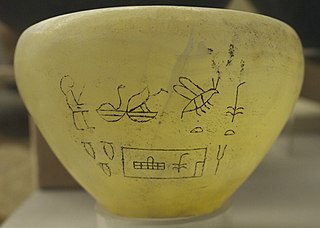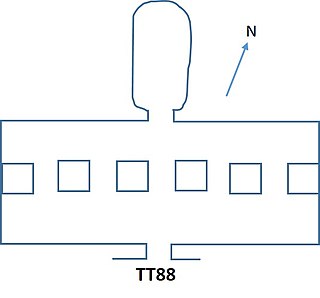
Hetepheres II was a queen of ancient Egypt during the 4th Dynasty.

Ahmose-Nefertari was the first Great Royal Wife of the 18th Dynasty of Ancient Egypt. She was a daughter of Seqenenre Tao and Ahhotep I, and royal sister and wife to Ahmose I. Her son Amenhotep I became pharaoh and she may have served as his regent when he was young. Ahmose-Nefertari was deified after her death.

Mentuhotep II, also known under his prenomen Nebhepetre, was an ancient Egyptian pharaoh, the sixth ruler of the Eleventh Dynasty. He is credited with reuniting Egypt, thus ending the turbulent First Intermediate Period and becoming the first pharaoh of the Middle Kingdom. He reigned for 51 years, according to the Turin King List. Mentuhotep II succeeded his father Intef III on the throne and was in turn succeeded by his son Mentuhotep III.

Huni was an ancient Egyptian king, the last pharaoh of the Third Dynasty of Egypt during the Old Kingdom period. Based on the Turin king list, he is commonly credited with a reign of 24 years, ending c. 2613 BC.

Menkauhor Kaiu was an Ancient Egyptian king of the Old Kingdom period. He was the seventh ruler of the Fifth Dynasty at the end of the 25th century BC or early in the 24th century BC.

Djedkare Isesi was a king, the eighth and penultimate ruler of the Fifth Dynasty of Egypt in the late 25th century to mid-24th century BC, during the Old Kingdom. Djedkare succeeded Menkauhor Kaiu and was in turn succeeded by Unas. His relationship to both of these kings remain uncertain, although it is often conjectured that Unas was Djedkare's son, owing to the smooth transition between the two.

Ancient Egyptian art refers to art produced in ancient Egypt between the 6th millennium BC and the 4th century AD, spanning from Prehistoric Egypt until the Christianization of Roman Egypt. It includes paintings, sculptures, drawings on papyrus, faience, jewelry, ivories, architecture, and other art media. It was a conservative tradition whose style changed very little over time. Much of the surviving examples comes from tombs and monuments, giving insight into the ancient Egyptian afterlife beliefs.

Semerkhet is the Horus name of an early Egyptian king who ruled during the First Dynasty. This ruler became known through a tragic legend handed down by the historian Manetho, who reported that a calamity of some sort occurred during Semerkhet's reign. The archaeological records seem to support the view that Semerkhet had a difficult time as king and some early archaeologists questioned the legitimacy of Semerkhet's succession to the Egyptian throne.

Mutnedjmet, also spelled Mutnodjmet, Mutnedjemet, etc., was an ancient Egyptian queen, the Great Royal Wife of Horemheb, the last ruler of the 18th Dynasty. The name, Mutnedjmet, translates as: "The sweet Mut" or "Mut is sweet." She was the second wife of Horemheb after Amenia who died before Horemheb became pharaoh.

The sculpture of the Seated Scribe or Squatting Scribe is a famous work of ancient Egyptian art. It represents a figure of a seated scribe at work. The sculpture was discovered at Saqqara, north of the alley of sphinxes leading to the Serapeum of Saqqara, in 1850, and dated to the period of the Old Kingdom, from either the 5th Dynasty, c. 2450–2325 BCE or the 4th Dynasty, 2620–2500 BCE. It is now in the Louvre.
Khamerernebty II was an ancient Egyptian queen of the 4th Dynasty. She was a daughter of Pharaoh Khafre and Queen Khamerernebty I. She married her brother Menkaure and she was the mother of Prince Khuenre.

Kanefer is the name of an ancient Egyptian prince. He lived during the 4th or early 5th Dynasty of the Old Kingdom period.

Meresankh II was a queen consort of Egypt who lived during 4th Dynasty.
Meresankh IV was an ancient Egyptian queen believed to have lived during the Fifth Dynasty of the Old Kingdom. Her familial ties are the subject of ongoing speculation.

Khuit I was an ancient Egyptian queen who has been tentatively dated by association to have lived during the 5th Dynasty of the Old Kingdom of Egypt.
Meresankh is the name of several royal women from the Old Kingdom in Ancient Egypt. It means "she loves life" and was popular during the 4th dynasty.
Hemetre (Hemetra) was an ancient Egyptian royal woman of the Fourth Dynasty. Hemetre may have been a daughter or granddaughter of Khafre. She did not hold the title king's wife and may have even married a non-royal. She is mainly known from her tomb, which is located in the central field of Giza. Her name honors the god Ra.
Nefertkau III was an ancient Egyptian princess. She lived during the 4th Dynasty. She was possibly a daughter of Meresankh II and Horbaef. If so, she was a granddaughter of King Khufu. Baud has proposed that Nefertkau was a daughter of Khufu instead. Nefertkau has the titles King's daughter of his body and Priestess of Neith in a scene in the chapel of her tomb. She was married to an official named Iynefer. Nefertkau and Iynefer had a daughter also called Nefertkau and two or three sons. Strudwick has suggested that Iynefer may be a son of Khufu. Depending on the interpretation of the family relationships, Nefertkau may have married either her uncle or her brother.
Djaty I was an ancient Egyptian prince during the 4th Dynasty. He was an overseer of a royal expedition.

The Theban Tomb TT88 is located in Sheikh Abd el-Qurna and is part of the Theban Necropolis, on the west bank of the Nile, opposite to Luxor. It is the burial place of the ancient Egyptian military official Pehsukher who lived in the 18th Dynasty. The monument is known to researchers since the beginning of the 19th century, but only received in 2023 a full publication.














